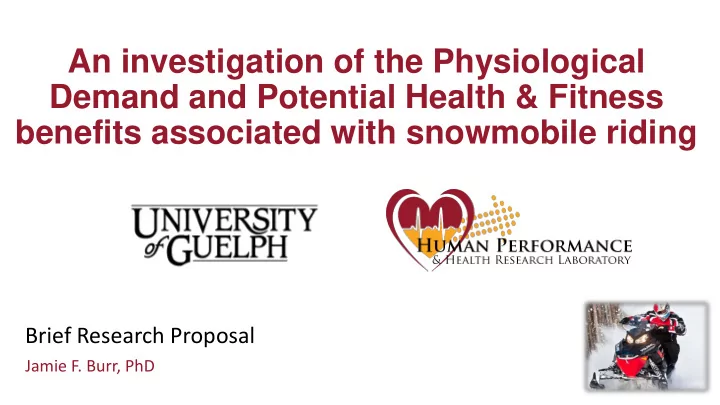

An investigation of the Physiological Demand and Potential Health & Fitness benefits associated with snowmobile riding Brief Research Proposal Jamie F. Burr, PhD
Purpose To o scie cientific icall lly evalu luate th the physic ical demand assoc ociated with ith th the safe op operation of of a snowmobil ile under ty typic ical l rid riding g con ondit itions exp xperien enced by North Americ ican snowmobile lers, and to o compare th the e dem emand to o natio tional rec ecommendations for or th the e promotion of of hea ealt lth and fitn fitnes ess Primary Outcomes • Aerobic exercise intensity (Metabolic demand) • Expressed as an average value over a ride, and considering % time between high and low intensity exposures • Expected effects on health and fitness – referencing American and Canadian activity guidelines and extrapolating from ATV/off-road motorcycling training study data • Characteristics of a typical ride (Frequency, Duration, Type) • Characteristics of a typical rider (Objective quantification of fitness, record of other training/activities etc) Figure 1: An example output from previous research published by the Dr. Burr considering off-road motorcycle and ATV riding
Hypotheses 1) Snowmobile Riding will be associated with an average physical demand that is significantly above resting and which falls into the general classification of moderate-vigorous physical activity (wherein health and fitness changes occur) • The majority of a ride will be in the “moderate” intensity zone, with infrequent excursions into “vigorous” activity 2) Substantial differences will exist according to the terrain type • This will dictate differences in riding style and physical demand between trail riding and off-piste riding
Three Phases Phase 2 Phase 1 Phase 3 Fall- Understanding riding behaviours February- Ontario/Quebec April- British Columbia Anticipated testing – 1 week (5-7 days) each site - Some of this data may already be available Conservative estimate 6 per day x 5d/wk = 30 per site (15m/15f) - Validation - Questions about perceptions of riding For both types of riding (physicality) - Other physical activity Understanding the demands of a typical trail ride - Lifestyle factors -representative course – using local experts and data from phase 1 - 15 to 20 minute sample - Surveys done online (in person at - Expressed relative to the individual’s maximum (thus potential for changes in snowmobile shows etc) health and fitness can be inferred) - Circulated via distribution networks and clubs - Indirect calorimetry (VO 2 ) - Heart rate response - Cardiac output - Riding characteristics (speed, altitude etc) – correlated with exercise intensity Portable metabolic monitor
Snowmobile: Physical Demands Analysis- Potential health and fitness Implications General study overview February November November December December September September January October October March August April May June July Data Identification of MSc Physical Analysis studies prep/ student and HQP training logistics collection Eastern Canada Primary Data Collection contingency Western Canada Primary Data Collection Phase 1, Survey Data Data Collection Data Reduction/ Analysis Manuscript Prep and presentations Spring/Summer Fall 2017 Winter 2017 Summer 2016 Winter 2017 Fall 2016
Other Project Requirements • Facilitator for phase one – connector to clubs, survey distribution • Access to snowmobiles, trails, experienced riders (subjects) • Modifiable helmets for testing (small, medium, large) • Testing facilities (temp controlled room, running water, power, internet access) • Budget – supplies (calibration gases, minor equipment and disposables, trainee stipend, publication costs, travel) • See included breakdowns and excel spreadsheet
Budget estimation - Overview • Budget projections- Total project cost $194K including required new equipment • University of Guelph contribution $111,000 • Estimated Research Costs $ 70-85K • This range incorporates possible government offset to leverage dedicated trainee • Largest single expense – University minimum stipend
Recommend
More recommend